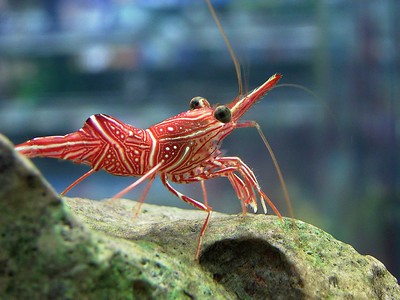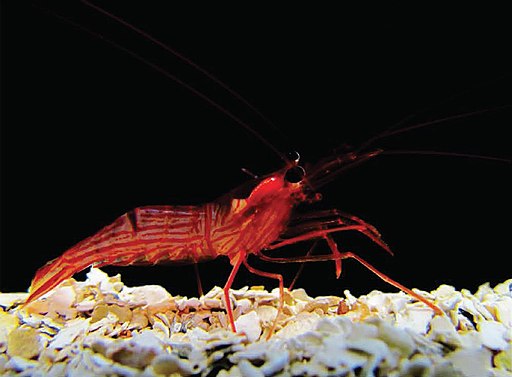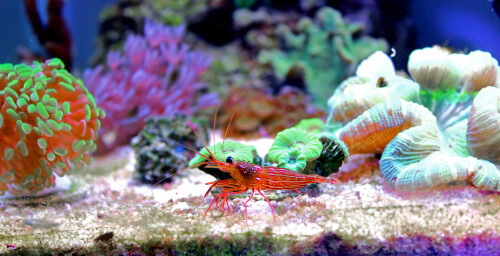Camel Shrimp vs Peppermint Shrimp: Species Comparison
Posted by on 3/16/2023
Both Camel Shrimp and Peppermint Shrimp are attractive species for hobbyists looking to add invertebrates to their saltwater aquariums. While these shrimps do share some similarities, they are two distinct species that have differences you should be aware of.
In this post, we'll compare these two popular shrimp species, and we'll summarize some of their similarities and differences so that you can decide whether or not one of these shrimp might be right for you.
December's Giveaways on Light Fish
Camel Shrimp
Camel shrimp (scientific name: Rhynchocinetes uritai) are attractive and easy to care for saltwater shrimp. These shrimp are native to the Indo-Pacific, where they typically live in groups in predator-safe areas, such as small caves and rock crevices.
Camel shrimp are nocturnal and similar to other shrimp, will occasionally shed their exoskeletons in a process known as molting .

Appearance
The unique appearance of Camel Shrimp is what often lands them on a saltwater aquarium hobbyist's radar. Camel shrimp have intricate color patterns, consisting of thin red and white dotted, circular, and rounded lines that cover the shrimp's body and extend onto their legs. An upturned rostrum extends in front of their black eyes, which are surrounded by antennas, which are utilized for their chemical receptors to locate food sources.
Size
Camel shrimp are a relatively small shrimp species, only growing to be about 1.5 inches in length. Males will typically have larger claws than their female counterparts.
Personality
Camel shrimp are quite shy, and due to them being nocturnal, you'll rarely see them moving around your aquarium. They prefer to be out of the spotlight, which is expected since this mimics the behavior seen in their native habitat.
Camel shrimp are not reef-safe, so if you're considering adding one of these shrimps to a reef tank, you should consider other invertebrates. Many hobbyists may choose to only keep camel shrimp in their sumps.

Diet
Camel shrimp are omnivorous, and will readily consume brine shrimp, plankton, and flake food.
Providing your camel shrimp with a nutrient-rich and well-balanced diet will help them reach their full life expectancy, which is about 3 years.
Peppermint Shrimp
Peppermint Shrimp (scientific name: Lysmata wurdemanni) are native to the Caribbean, and the United States's eastern coastline, stretching as far north as the state of New York and as far south as the state of Florida. These shrimp may frequently be mislabeled as Camel shrimp, which isn't surprising as their appearances are quite similar.
Peppermint shrimp are usually wanted for their Aiptasia-eating abilities, but hobbyists should be aware that only a few peppermint shrimp species are known to readily consume Aiptaisa. Lysmata wurdemanni, Lysmata ankeri, Lysmata boggessi, and Lysmata rafa are known to eat Aiptasia, and Lysmata wurdemanni is the only species of the four that has a reputation for being reef safe.
Appearance
Peppermint shrimp share a similar candy-cane appearance as the camel shrimp, and feature translucent bodies with red stripes However, peppermint shrimp under the Lysmata genus do not have the brightly colored white stripes seen in camel shrimp.
There are dozens of different types of peppermint shrimp species, and while there are some subtle differences in the richness of their red coloration, all will have translucent bodies.
Size
Peppermint shrimp are small and tend to be about half an inch larger than their similar-looking camel shrimp counterparts. When provided a well-balanced diet, peppermint shrimp will grow to reach about 2 inches in length.
Personality
Peppermint shrimp are active scavengers. While they tend to be a bit shy when first introduced into an aquarium, over time, they'll become more confident and move about the aquarium. Peppermint shrimp are nocturnal, and will be most active at night, but aren't as reclusive as the similar-looking camel shrimp.
Peppermint shrimp also have a peaceful temperament, and will get along with a wide variety of other tank mates, including fish such as clownfish, and the yellow watchman goby. Avoid species that consume invertebrates, such as the Yellow Coris Wrasse.
Diet
Peppermint shrimp are carnivorous invertebrates and will consume prepared foods such as mysis shrimp, brine shrimp, krill, and clams.
Aim to feed your peppermint shrimp at least 1-2 times per day.
Best Choice for Hobbyists on a Budget
Hobbyists looking to purchase the more affordable option should look to purchase the Peppermint shrimp. In the United States, these shrimp are typically sold for $8-12 dollars per shrimp.
Camel shrimp on the other hand tend to be a bit pricier, going for about $15 for a single shrimp.
Best Choice for an Aiptasia Outbreak
If you're experiencing an Aiptasia outbreak, and you own a tank that does not contain any anemones or corals, your best bet is going with any of the following peppermint shrimp species.
- Lysmata wurdemanni
- Lysmata ankeri
- Lysmata boggessi
- Lysmata rafa
These peppermint shrimp come from the Florida Keys and the Gulf of Mexico and have been scientifically studied for their Aiptasia consumption.
Best Choice for a Reef Tank
If you own a tank with corals such as blastos, torches, or chalices, or anemones such as the black widow, you'll be limited to only one reef-safe species, the peppermint shrimp Lysmata wurdemanni.
Lysmata wurdemanni has earned a reputation for consuming Aiptasia while remaining safe for anemones and corals.

Best Choice for a Non-Reef Tank
If you own a FOWLR (fish only with live rock) tank, we recommend going with a camel shrimp. The red and white coloration of these shrimp will stand out in a saltwater aquarium, and their peaceful temperament makes them an excellent option for invertebrate-safe fish species.
However, since you're not limited by corals and anemones, if you prefer the appearance of peppermint shrimp, go for it!
Conclusion
As you can see, camel shrimp and peppermint shrimp are two invertebrates that can exist comfortably in an at-home aquarium. However, due to their diets, hobbyists will want to avoid these shrimp if they are maintaining a reef aquarium.
However, if you plan on adding one of these shrimp to a FOWLR tank, their shy personalities are interesting to observe in the comfort of your home. Now that we've covered some of the differences between these different types of shrimp, do you plan on purchasing one? Let us know in the comments, and be sure to visit our marketplace and community forum where you can buy and sell with other aquarium hobbyists.
December's Giveaways on Light Fish


